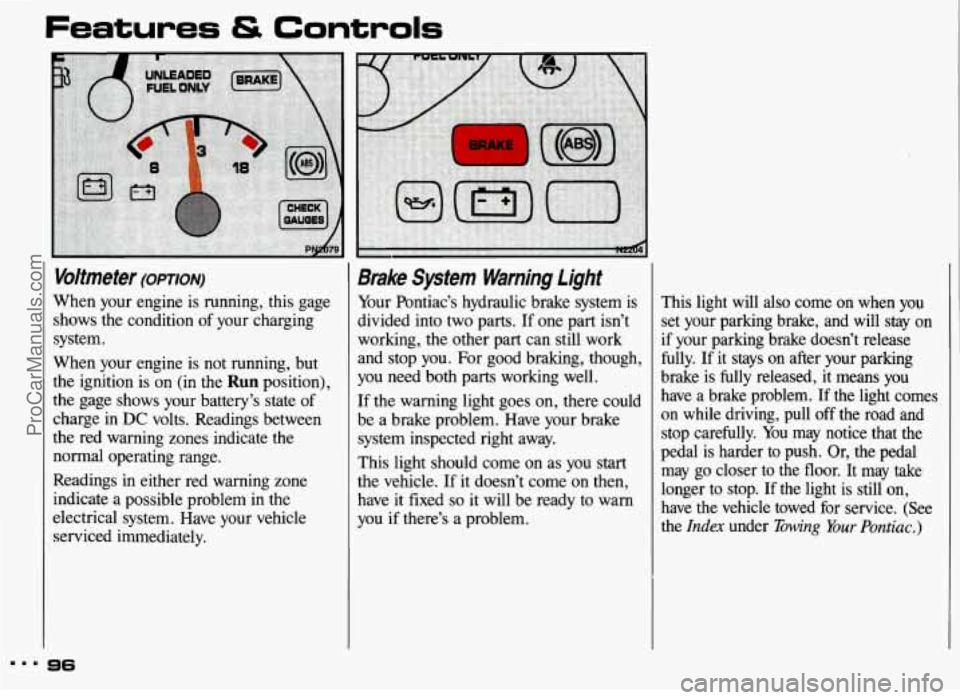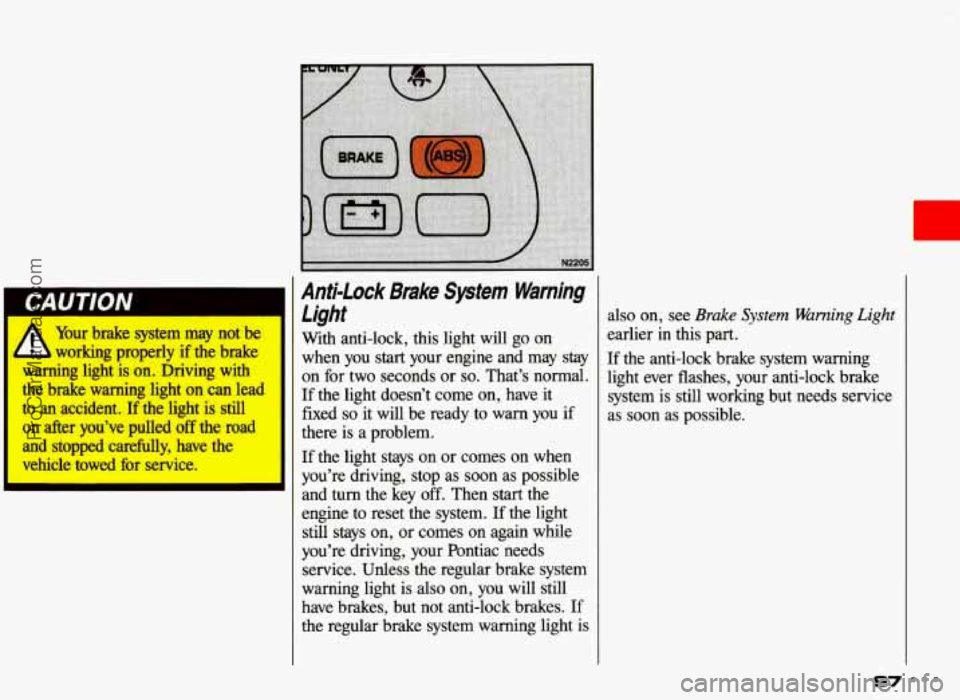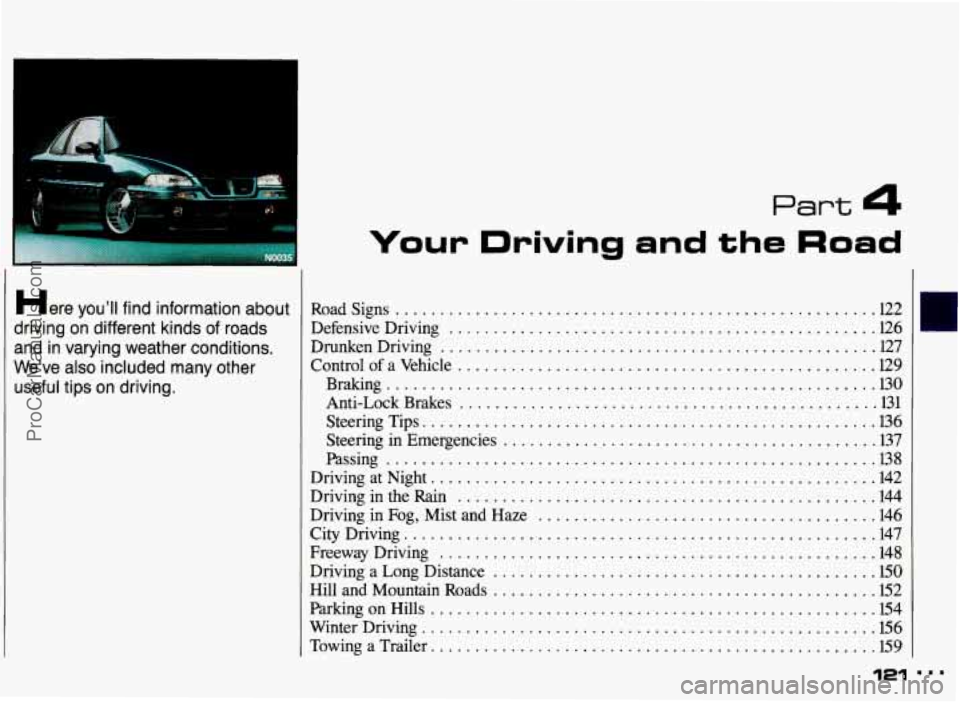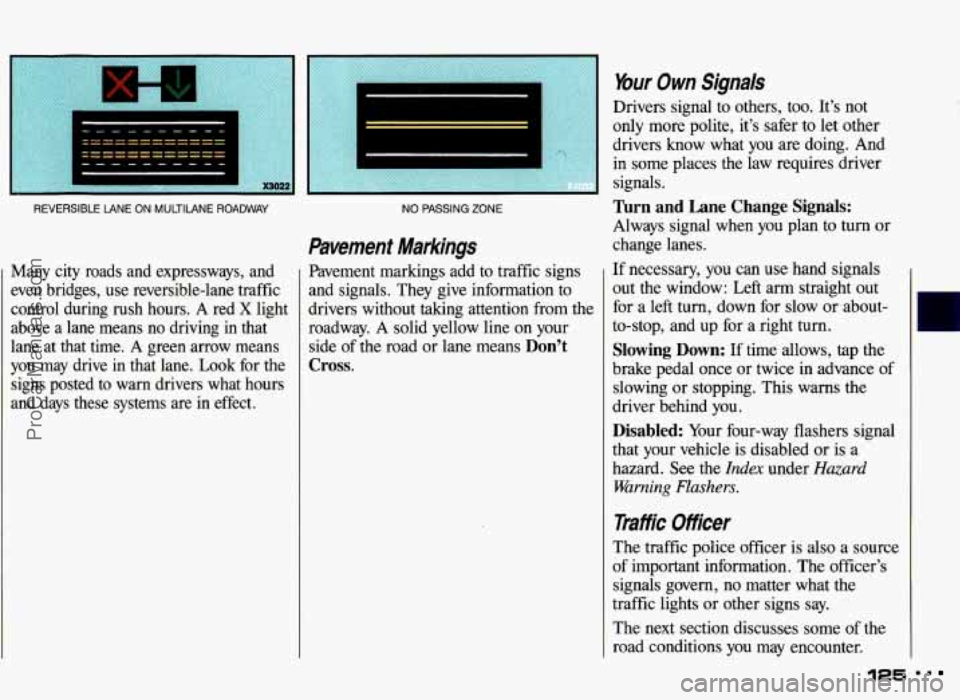1993 PONTIAC GRAND-AM brake
[x] Cancel search: brakePage 74 of 306

To Reduce Speed While Using
Cruise Control
There are two ways to reduce your
speed while using cruise control:
Push in the button at the end of the
lever until you reach the lower speed
you want, then release it.
To slow down in very small amounts,
push the button for less than half a
second. Each time you
do this, you’ll
go
1 mph (1.6 h/h) slower.
Passing Another Vehic/e While
Using Cruise Control
Use the accelerator pedal to increase
your speed. When you take your foot off
the pedal, your vehicle will slow down
to the cruise control speed you set
earlier.
Using Cruise Control on Hi&
How well your cruise control will work
on hills depends upon your speed, load,
and the steepness
of the hills. When
going up steep hills, you may have to
step on the accelerator pedal to maintain
your speed. When going downhill, you
may have to brake or shift
to a lower
gear to keep your speed down, Of
course, applying the brake or clutch
pedal takes you out
of cruise control.
Many drivers find this to be too much
trouble and don’t use cruise control on
steep hills.
73
ProCarManuals.com
Page 75 of 306

Features & Controls
I
I'
To Get Out of Cruise Control
There are two ways to turn off the cruise
control:
Step lightly on the brake pedal or push
the clutch pedal, if you have
a manual
transaxle; OR
Move the cruise switch to OFF.
To Erase Cruise Speed Memory
When you turn off the cruise control or
the ignition, your cruise control set
speed memory is erased.
74
. .. .. .. . , .. PN210!
Light Controls
Parking Lights:
Rotate the switch up to pf to turn on
Parking Lights
Side Marker Lights
Taillights
Instrument Panel Lights
Headlights:
Rotate the switch to , , ,- to turn on:
Headlights
Parking Lights
Side Marker Lights
Taillights
Instrument Panel Lights
Rotate the switch
to OF" to turn all the
lights off.
-'D
Operation of Lights
Although your vehicle's lighting system
(headlamps, parking lamps, fog lamps,
side marker lamps and taillamps) meets
all applicable federal lighting requirements,
certain states and provinces may apply
their own lighting regulations that may
require special attention before you
operate these lamps. For example, some
jurisdictions may require that you
operate your lower beam lamps with fog
lamps at all times, or that headlamps be
turned
on whenever you must use your
windshield wipers.
In addition, most
jurisdictions prohibit driving solely with
parking lamps, especially at dawn
or
dusk. It is recommended that you check
with your own state
or provincial
highway authority for applicable lighting
regulations.
c ProCarManuals.com
Page 76 of 306

lights On Reminder
If you open the driver’s door while
leaving the lights on, you will hear a
warning chime.
Daytime Running lights
(CANADA ONLY)
The Canadian federal government has
decided that Daytime Running Lights
(DRL) are a useful feature, in that DRL
can make your vehicle more visible to
pedestrians and other drivers during
daylight hours. DRL are required on
new vehicles sold in Canada.
Your DRL work with a light sensor
on
top of the instrument panel. Don’t cover
it up.
The high beam headlights will come on
at reduced brightness in daylight when:
The ignition is on
The headlight switch is off, and
The parking brake is released on a
manual transaxle; or
The shift lever is shifted out of
P (Park) or N (Neutral) on an
automatic transaxle. At
dusk, the exterior lights and
headlights will come on automatically.
At dawn, the exterior lights will go out
and the high beams will change to the
reduced brightness
of DRL again (if the
headlight switch is
off).
Of course, you may still turn on the
headlights any time you need to.
To idle your vehicle with the DRL
off,
set the parking brake on a manual
transaxle or put the vehicle in
P (Park)
or
N (Neutral) on an automatic
transaxle, while the ignition is in the
Off or Lock position. Then start the
vehicle. The DRL will
stay off until you
release the parking brake on a manual
transaxle or shift out
of P (Park) or
N (Neutral) on an automatic transaxle.
75
ProCarManuals.com
Page 88 of 306

The lnstrument Panel-
bur Information System
Your instrument panel is designed to let
you know at a glance how your vehicle
is running. You’ll know how fast you’re going, how much fuel you’re using, and
many other things you’ll need to drive
safely and economically.
The main components
of your
instrument panel are:
1. Fog Light Switch
2. Instrument Panel Intensity
3. Side Vent
4. Turn SignaUHeadlight Beam Lever Control/Interior Lights Switch
5. Hazard Warning Flashers Switch
6. Instrument
Cluster
7. Windshield Wiper/Washer Stalk
8. Center Vent
9. Audio System
1 0. Side Vent
1 1. Side Window Defogger Vent
12. Glove Box
1 3. Climate Control System
14. Ashtray/Lighter
15. Gear Shift Lever
16. Rear Window Defogger (Option)
17. Ignition Switch
18. Horn
1 9. Tilt Steering Wheel Lever (Option)
20. Parking Brake Release Lever
21. Hood Release Handle
22. Fuse Panel
I
ProCarManuals.com
Page 97 of 306

Features & Controls
Voltmeter (omoN)
When your engine is running, this gage
shows the condition of your charging
system.
When your engine is not running, but
the ignition is on (in the
Run position),
the gage shows your battery’s state of
charge in
DC volts. Readings between
the red warning zones indicate the
normal operating range.
Readings in either red warning zone
indicate a possible problem in the
electrical system. Have your vehicle
serviced immediately.
Brake System Warning Light
Your Pontiac’s hydraulic brake system is
divided into two parts. If one part isn’t
working, the other part can still work
and stop you. For good braking, though,
you need both parts working well.
If the warning light goes on, there could
be a brake problem. Have your brake
system inspected right away.
This light should come on as you start
the vehicle. If it doesn’t come
on then,
have it fixed
so it will be ready to warn
you if there’s a problem, This
light will
also come on when you
set your parking brake, and will stay on if your parking brake doesn’t release
fully. If it stays on after your parking
brake is
fully released, it means you
have a brake problem.
If the light comes
on while driving, pull off the road and
stop carefully. You may notice that the
pedal is harder to push. Or, the pedal
may
go closer to the floor. It may take
longer to stop. If the light is still on,
have the vehicle towed for service. (See
the
Index under Bwing Your Pontiac.)
m.. 96
ProCarManuals.com
Page 98 of 306

I CAUTION Anti-lock Brake Sptetn Warning
Light A Your brake system may not be
working properly if the brake
warning light is on. Driving with
the brake warning light on can lead
to
an accident. If the light is still
on after you’ve pulled off the road
and stopped carefully, have the
vehicle towed for service. Vith
anti-lock, this light will
go on
when you start your engine and may stay
on for two seconds or so. That’s normal.
If the light doesn’t come on, have it
fixed so it will be ready to warn you if
there is a problem.
If the light
stays on or comes on when
you’re driving, stop
as soon as possible
and turn the key off. Then start the
engine to reset the system.
If the light
still
stays on, or comes on again while
you’re driving, your Pontiac needs
service. Unless the regular brake system
warning light
is also on, you will still
have brakes, but not anti-lock brakes.
If
the regular brake system warning light is
also on, see Brake System Warning Light
earlier in this part.
If the anti-lock brake system warning
light ever flashes, your anti-lock brake
system
is still working but needs service
as soon as possible.
ProCarManuals.com
Page 122 of 306

Part 4
Your Driving and the Road
Here you’ll find information about
driving on different kinds of roads
and in varying weather conditions
.
We’ve also included many other
useful tips on driving
.
Roadsigns ...................................................... 122
Defensive Driving ................................................ 126
Drunken Driving ................................................. 127
Control of a Vehicle ............................................... 129
Steering Tips
................................................... 136
Steering in Emergencies .......................................... 137
DrivingatNight
.................................................. 142
Driving in the Rain
............................................... 144
Driving in
Fog, Mist and Haze ...................................... 146
Freeway Driving
................................................. 148
Driving a Long Distance ........................................... EO
Hill and Mountain Roads ........................................... 152
ParkingonHills .................................................. 154
Winter Driving
................................................... E6
Towing a Trailer ..................... ......................... 159
Braking
....................................................... 130
Anti-LockBrakes
............................................... 131
Passing
....................................................... 138
CityDriving ..................................................... 147
121
ProCarManuals.com
Page 126 of 306

REVERSIBLE tANE ON MULTtlANE ROADWAY
Many city roads and expressways, and
even bridges, use reversible-lane traffic
control during rush hours.
A red X light
above a lane means no driving in that
lane at that time.
A green arrow means
you may drive in that lane. Look for the
signs posted to warn drivers what hours
and days these systems are in effect.
NO PASSING ZONE
Pavement Markings
Pavement markings add to traffic signs
and signals. They give information to
drivers without taking attention from the
roadway.
A solid yellow line on your
side of the road or lane means
Don’t
Cross.
bur Own Signals
Drivers signal to others, too. It’s not
only more polite, it’s safer to let other
drivers
know what you are doing. And
in some places the law requires driver
signals.
Turn and Lane Change Signals:
Always signal when you plan to turn or
change lanes.
If necessary,
you can use hand signals
out the window:
Left arm straight out
for
a left turn, down for slow or about-
to-stop, and up for a right turn.
Slowing Down: If time allows, tap the
brake pedal once or twice
in advance of
slowing
or stopping. This warns the
driver behind you.
Disabled: Your four-way flashers signal
that your vehicle is disabled
or is a
hazard. See the
Index under Hazard
Warning Flashers.
liffk Ofiiceer
The traffic police officer is also a source
of important information. The officer’s
signals govern, no matter what the
traffic lights or other signs
say.
The next section discusses some of the
road conditions you may encounter.
125
ProCarManuals.com